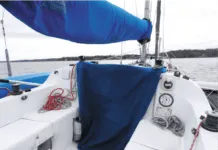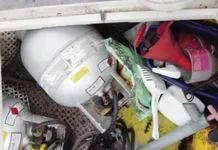Sizing Up Improvements In Low Friction Rings
The first time I brought a handful of low friction rings (LFR) to the boat, I got funny looks from my partner. The plan...
Outboard Steering Tricks
Outboard powered boats can be slow to respond when maneuvering around the docks at low speed. With no prop wash over the rudder, it...
What Color Bimini Top is Best for Summer?
So you want to build the awning described on page 7 of this issue, and were wondering what material to use. We’ve been using...
Revive Your Mast Like a Pro
Unobtainium is the metal at the top of every Naval Architect’s wish list. It’s a perfect marine material; light, strong, stiff yet flexible—it’s as...
Drudging To a Safe Landing
The word ‘drudging’ can be traced to the middle-English word for dragging. It is the practice of using a chain, heavy weight, or anchor...
Spinnaker Tips for Multihulls
A Practical Sailor reader recently reached out to me with a question regarding light air sails on catamarans: “I’ve owned two catamarans, and have...
Arborist Gear for Solo Mast Ascents
My introduction to rope walking ascent was caving back in the 1970s. Each trip started with 75-200 drop straight into a sink hole, followed...
Excel Anchor Offers Case Study in Design
At first glance, the Sarca Excel is a Delta clone with a few added creases in the sheet metal, explaining the public perception that...
Sailboat Rig Inspection Tips
How frequently do you bother removing spreader boots and taping to check the condition of the spreaders and rigging? No matter how well the spreader ends are protected, and whether you use ready-made vinyl spreader boots or conventional rigging tape, water will get through to the fittings inside. On a boat used in salt water, the atmosphere's corrosive nature can cause rapid disintegration of aluminum fittings (nevermind the fact that the spreaders might be 25 feet or more off the water). The thorough taping job you did on the spreader ends may actually accelerate the problem by holding in water.
A Second Look at Anchor Fluke Shape
The new anchoring myth making rounds on the internet is that a scoop shape is what makes an anchor hold. Though it seems logical,...
















































